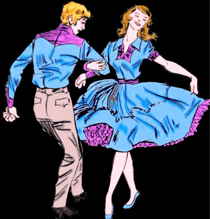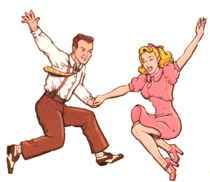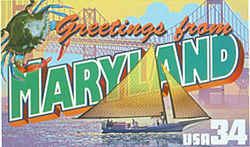Maryland State Folk Dance
Square Dance

Adopted in 1994.
The House Appropriations Committee approved the legislation on April 9, 1994. The bill was approved by the House of Delegates and the Senate and forwarded to Governor William Donald Schaeffer for his signature. On May 27, 1994, he signed the legislation designating square dancing as the official state folk dance of Maryland.
Maryland State Folk Dance: Square Dance
What happened in Maryland
 Early in 1994, a bill,
sponsored by State Senator Leo Green, was introduced in to the Maryland Assembly declaring square dance the state folk dance of Maryland.
The bill described square dancing as representing the American melting pot by blending the Morris and Maypole dances of England, the ballroom dances
of France, the Church dances of Spain, and the folk dances of countless other countries. The bill also invoked the symbols of family values, wholesomeness,
and benefits to the handicapped and elderly, and used these to justify square dancing as representative of the state of Maryland.
Early in 1994, a bill,
sponsored by State Senator Leo Green, was introduced in to the Maryland Assembly declaring square dance the state folk dance of Maryland.
The bill described square dancing as representing the American melting pot by blending the Morris and Maypole dances of England, the ballroom dances
of France, the Church dances of Spain, and the folk dances of countless other countries. The bill also invoked the symbols of family values, wholesomeness,
and benefits to the handicapped and elderly, and used these to justify square dancing as representative of the state of Maryland.
The only individual to testify against the bill at the hearings in Annapolis was Stan Fowler. Stan manages the dance program at the Glen Echo Park
in Glen Echo, Maryland, which includes contras & squares, Cajun, zydeco, big band, and swing. Stan testified as a concerned citizen and dancer
of the state of Maryland, and not as a representative of the National Park Service, which runs the park.
Stan's testimony pointed out the importance of state symbols. Choosing the same state folk dance as nearly two dozen other states defeats the purpose
of a state symbol to distinguish that state from others. There is nothing about club square dancing that represents Maryland. You can go to a mainstream
modern Western square dance club in Maryland and then to one in Minnesota or Arizona and find little or no difference in their dancing. Stan also offered
the exclusionary nature of club square dancing as another reason that the bill was inappropriate for the state of Maryland. He quoted an article in
the Washington Post from February 6, 1987, in which a historian for a local modern Western square dance association said, "We kind of look down our
nose at square dancing over at Glen Echo. It's totally open to the public, and they don't meet our criteria for being a member of the Washington Area
Square Dance Cooperative Association."
Most important, Stan Fowler's testimony brought up the issue of cultural diversity. "Frankly, I do not see the need for Maryland to select a state
dance. It would be hard to select a truly representative one because of the rich variety of dances done in Maryland and because of the diversity of
Maryland's population."
A vote was taken immediately after the hearing at which Stan Fowler testified. The measure was defeated unanimously. The club square dancers, however,
would not give up so easily. Within days, a letter was sent to Mr. Howard Rawlings, the chairman of the committee which held the March 29 hearing.
Richard Peterson, of the Washington Area Square Dance Cooperative Association, implored the committee to reconsider its vote, and included a reference
to the national square dance convention: "We had intended to bid for the national square dance convention again...this June. In 1984, we had the national
in Baltimore and attracted over 25,000 square dancers. With the negative vote we received from the House Appropriations Committee, this makes our bid
rather useless. The conventions have been going to other states that have passed the legislation." On April 9, the committee voted again on the bill
and it passed.
On May 27, Governor William Donald Schaeffer signed a bill designating square dance (as defined by modern Western square dancers) the state folk dance
of Maryland. This was despite petitions, phone calls, and letters of opposition from dancers who participate in the dances sponsored by the Folklore
Society of Greater Washington, the Baltimore Folk Music Society, the Mid- Maryland Folk Arts Council, and the Annapolis Traditional Dance Society.
It appears that the politicians sold out to the economic benefit of a national square dance convention being held in Maryland. One can only wonder
what is the value of a state symbol. For Maryland, it seems to be a convention that has yet to be actually scheduled in Maryland. Even if one is scheduled
for Maryland, it will be a convention that is not likely to be scheduled more than once every twenty years. Club square dancers in every state are
likely to use the same ploy on their legislatures.
Exerpt from
The State Folk Dance Conspiracy: Fabricating a National Folk Dance
by Julie Mangin
Originally published in the Old-Time Herald, v.4(7) p.9-12, Spring 1995
Maryland Law
The law designating square dancing as the official Maryland state folk dance is found in the Maryland Statutes, Title 13, Section 13-314.
STATE GOVERNMENT
TITLE 13. EMBLEMS; COMMEMORATIVE DAYS; MANUAL.
SUBTITLE 3. ADDITIONAL EMBLEMS; DESIGNATIONS.
SECTION 13-314.
§13-314. Folk Dance. Square dancing is the State folk dance.
[1994, ch. 707.]








